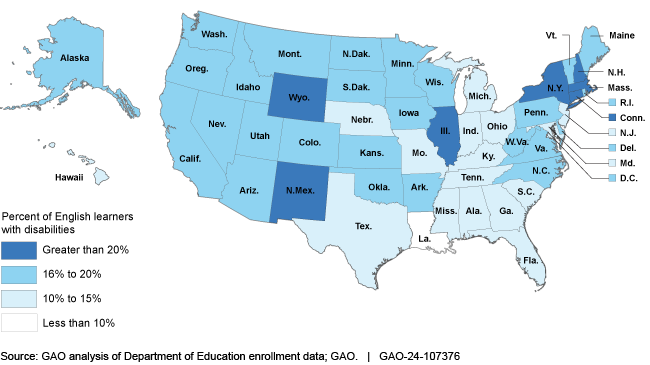K-12 Education: How States Identify English Learners, Including Those with Disabilities
Fast Facts
States must ensure school districts identify students who need English language services to participate fully in the classroom. States must also ensure that all children with disabilities residing in their state are evaluated.
In this Q&A, we reported on how schools identify students needing English services. It can be hard to determine whether a specific educational challenge is related to a student's disability, their English-language acquisition, or both.
Most states reported assisting with distinguishing between students' language acquisition issues, specific learning disabilities, or speech-language impairment within the past 3 years.
Percentage of Enrolled K-12 English Learners with Disabilities by State, School Year 2021-2022

Highlights
What GAO Found
States must ensure school districts take appropriate action to overcome language barriers that impede equal participation in instruction. School districts generally use a home language survey to identify students who might be English learners. This survey is administered to families when children first enroll in a school.
As of fall 2020, English learners accounted for about 10.1 percent of all K-12 public school students. In school year 2021–2022, 15.8 percent of English learners were children with one or more disabilities, according to Department of Education data.
On GAO's survey of all 50 states and the District of Columbia (states), 48 states reported using a set of three Education-suggested questions in their home language surveys to some extent.
Thirty-two states reported taking steps to assess the quality of their process for identifying English learners. The most common step was to assess the policies, procedures, and guidelines related to identification.
Most states (41 states) reported providing recent assistance to schools, districts, or both to help them distinguish between students having language acquisition issues, specific learning disabilities, or a speech language impairment. Of these, 17 reported taking steps to determine how well schools, districts, or both made these distinctions.
Why GAO Did This Study
GAO was asked to examine how states and districts identify students who are English learners and ensure that they are accurately identifying those who are English learners with disabilities. GAO's review examined how states ensure the effectiveness of their home language surveys and the extent to which states help school districts properly identify English learners who have disabilities.
To do this work, GAO surveyed all 50 states and the District of Columbia and received responses from all but Utah. The survey asked questions about the characteristics and the effectiveness of state screening tools that school districts use to identify English learners and the assistance that states provide to help school districts identify English learners who have disabilities. GAO also interviewed representatives of four states—California, Delaware, Massachusetts, and Nevada—selected because they have relatively large populations of students who are English learners. GAO also interviewed experts on English learners to obtain additional information about the identification of English learners, including those with disabilities.
For more information, contact Jacqueline M. Nowicki at (202) 512-7215 or NowickiJ@gao.gov.
